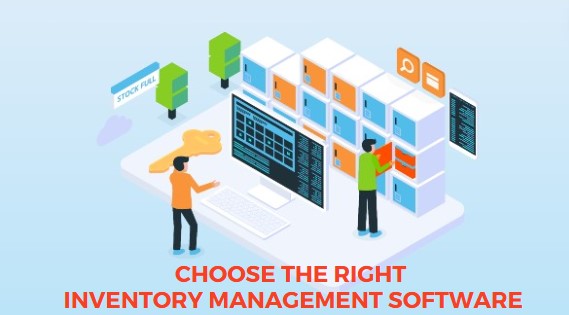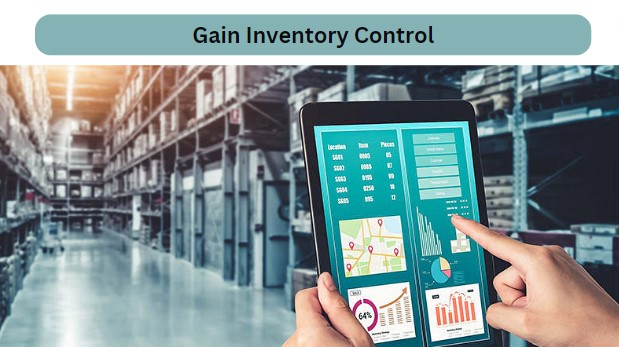
Choosing the Right Inventory Management Software
Madhurima Sanyal |
23 Feb 2024 |
18:13 PM
- What is an inventory management system?
- The Importance of a Sound Inventory Management Systems
- Choosing the Right Inventory Management System
- Understanding Inventory Management Software
- A Five-Step Process in Inventory Management system
- Understanding Inventory Management Tools
- Consequences of Poor Inventory Management software
- Risks in the event of mismanaging stocks
- Benefits of Using Inventory Management Software
- How inventory management software can make a difference
- Conclusion

10 Proven Ways to Reduce Downtime in Manufacturing
Madhurima Sanyal 07 Jan 2024 | 16:50 PMDiscover 10 proven strategies to reduce downtime in manufacturing, enhance efficiency, and streamline processes in 2024. Explore actionable insights and solutions....
Understanding Inventory Management Systems
What is an inventory management system?
An inventory management system refers to a set of tools and processes designed to oversee the flow of goods within a business. It tracks the movement of inventory from procurement to sale, offering real-time visibility into stock levels, sales trends, and order fulfillment. By centralizing crucial data, these systems enable businesses to make informed decisions, optimize inventory levels, and streamline operations.
Benefits of using an inventory system
The benefits of implementing best inventory management software are manifold. Firstly, it enhances accuracy by minimizing errors associated with manual data entry. Secondly, it improves efficiency by automating tasks such as order processing and replenishment. It also enhances customer satisfaction by ensuring products are readily available for purchase.
Moreover, it facilitates better decision-making through comprehensive reporting and analytics capabilities. Overall, best inventory management system empowers businesses to reduce costs, increase productivity, and stay competitive in today's dynamic market.
Key inventory management system features
Best inventory management systems come equipped with a range of features to streamline inventory operations. These include inventory tracking, order management, barcode scanning, and integration with business software.
Also, advanced systems offer functionalities such as demand forecasting, multiple warehouse management, and support for sales across various channels. The key is to choose a system that aligns with your business needs and growth objectives, ensuring maximum efficiency and profitability.
The Importance of a Sound Inventory Management Systems

How can an inventory management system help?
An inventory management system plays a crucial role in modern business operations by providing a comprehensive solution for handling inventory-related tasks. It helps businesses maintain optimal stock levels by tracking inventory in real-time and providing insights into sales trends and customer demand. By automating order management processes such as order processing, invoicing, and inventory tracking, it minimizes the risk of errors and reduces operational costs.
Why It's Critical to Have a Sound Inventory Management System
Having a sound inventory management system is critical as it ensures optimal stock levels, minimizes errors, and enhances efficiency in tracking and managing inventory, as projected by demand forecasting trends.
Closely track incoming & outgoing inventory - Firstly, it allows businesses to closely track incoming and outgoing inventory, ensuring that stock levels are always optimized to meet customer demand without excess or shortages.
Automate to simplify fulfillment complexities - It automates various aspects of inventory management, simplifying fulfillment complexities and reducing the time and resources required for manual tasks.
Streamline warehouse management - It streamlines warehouse management by organizing inventory efficiently, improving inventory turnover, and reducing carrying costs.

Maintain strong customer relationships - It helps maintain strong customer relationships by ensuring timely order fulfillment, minimizing stockouts, and providing accurate sales and inventory data for better customer service and decision-making.
Choosing the Right Inventory Management System
Factors to Consider: When selecting the right inventory management system for your business, several key factors should be considered to ensure optimal performance and alignment with your specific requirements:
Cost and Budget - Evaluate the cost of implementation and ongoing maintenance against your budget constraints. Look for a solution that offers a balance between affordability and functionality, considering both upfront expenses and long-term value.

Customizations - Assess the level of customization offered by the inventory management system to tailor it to your unique business processes and workflows. A flexible system that can adapt to your evolving needs is essential for maximizing efficiency and productivity.
Your Business Size - Consider the scale and complexity of your operations when choosing an inventory management system. Whether you're a small startup or a large enterprise with multiple warehouses, select a solution that can scale with your business and accommodate your current and future needs.
System Support - Ensure that the inventory management system provider offers comprehensive support services, including technical assistance, training, and troubleshooting. Prompt and reliable support is crucial for minimizing downtime and resolving any issues that may arise.
Your Unique Needs - Identify your specific requirements and objectives for inventory management, such as inventory tracking, order fulfillment, and raw material management. Choose a system that addresses these needs effectively and offers features tailored to your industry and business model.
Integration Capabilities - Evaluate the system's integration capabilities with other software solutions and third-party applications used in your business ecosystem. Seamless integration with accounting software, e-commerce platforms, and multiple sales channels can streamline operations and enhance data accuracy.
Cloud-based - Consider opting for a cloud-based inventory system that offers the flexibility of remote access, scalability, and automatic updates. Cloud-based solutions provide real-time visibility into inventory data and enable collaboration across multiple locations.
Positive Reviews - Research and review feedback from other users and industry experts to gauge the reputation and reliability of the inventory system provider. Positive reviews and testimonials can offer valuable insights into the system's performance, usability, and customer satisfaction.
By carefully considering these factors and conducting thorough research, you can choose the right inventory management system that aligns with your business goals and drives success.
Understanding Inventory Management Software
What is inventory management software and why do you need it?
Inventory management software is a specialized tool designed to help businesses efficiently track, manage, and optimize their inventory levels and operations. It automates processes such as inventory tracking, order management, and stock replenishment, providing real-time visibility into inventory data. Businesses need inventory management software to streamline their operations, reduce costs, minimize errors, and improve overall efficiency in managing their inventory.
Important factors of inventory management software
Versatility - Choose inventory management software that offers versatility to adapt to your small businesses or retail businesses. Look for a solution that can handle various types of inventory, including raw materials, finished goods, and perishable items, and can accommodate different industries and business models.
Free Trial - Opt for software that offers a free trial period to evaluate its features, functionality, and usability before making a commitment. A free trial allows you to test the software in a real-world environment and determine if it meets your requirements and expectations.
Budget - Consider the cost of implementing and maintaining the inventory management software within your budget constraints. Look for a solution that offers transparent pricing with no hidden fees and provides value for money in terms of features, support, and scalability.
Integration - Ensure that the inventory management software integrates seamlessly with your existing systems, such as accounting software, e-commerce platforms, and supply chain management tools. Integration eliminates manual data entry and ensures consistency and accuracy across your business processes.

Flexibility - Select software that offers flexibility to accommodate changes in your business environment, such as business growth, expansion, or shifting priorities. A flexible solution allows you to customize workflows, adjust settings, and add or remove features as needed to meet your evolving requirements.
Overall Cost - Evaluate the overall cost of ownership of the inventory management software, including upfront expenses, ongoing maintenance, and potential upgrades. Consider the long-term benefits and return on investment (ROI) offered by the software in terms of efficiency gains, cost savings, and improved productivity.
Customer Support - Choose a software provider that offers reliable customer support services, including technical assistance, training, and troubleshooting. Responsive and knowledgeable support can help resolve issues quickly and ensure smooth implementation and operation of the software.
Ease of Understanding - Look for inventory management software with an intuitive user interface and user-friendly design that makes it easy to navigate and use. Clear instructions, tooltips, and help resources can enhance user adoption and minimize training time.
Your Requirements - Identify your specific requirements and objectives for inventory management software, such as inventory tracking, order processing, and supply chain visibility. Choose a solution that aligns with your business goals and addresses your most critical needs effectively.
Possibility to Customize - Select software that offers customization options to tailor it to your unique business processes and workflows. Customization allows you to adapt the software to fit your specific requirements and preferences, improving efficiency and usability.
By considering these important factors and evaluating inventory management system based on your specific needs and priorities, you can choose the best solution for your business and achieve effective inventory management.
A Five-Step Process in Inventory Management system
Replenishment method
The replenishment method involves determining when and how much inventory to reorder to maintain optimal stock levels. Businesses can use various replenishment methods such as the economic order quantity (EOQ) model, just-in-time (JIT) inventory system, or reorder point method to calculate reorder quantities based on factors like demand forecasts, lead times, and inventory costs.
The point-of-command management method
This method involves identifying key decision points in the inventory management process, such as when to place orders, when to receive shipments, and when to fulfill customer orders. By establishing clear command points and standard operating procedures (SOPs), businesses can ensure timely and efficient inventory management and minimize delays or errors in the process.
The second aspect of the replenishment method
In this step, businesses focus on optimizing inventory levels and replenishment frequencies to balance the costs of holding inventory with the risks of stockouts or backorders. By analyzing historical sales data, demand patterns, and lead times, businesses can fine-tune their replenishment strategies to meet customer demand while minimizing excess inventory and associated holding costs.
The order replenishment method
This method involves generating purchase orders or production orders based on the replenishment parameters determined in earlier steps. Businesses need to consider factors such as supplier lead times, order quantities, and order cycles to ensure timely replenishment of inventory and avoid stockouts or overstock situations.
Development of an Action Plan
Finally, businesses should develop a comprehensive action plan outlining the steps, timelines, and responsibilities for implementing and managing the inventory management system. This plan should include tasks such as data collection and analysis, system implementation and training, ongoing monitoring and review, and continuous improvement initiatives.
By following this five-step process, businesses can establish an effective inventory management system that optimizes inventory levels, improves operational efficiency, and enhances overall supply chain performance. Regular monitoring and refinement of the system are essential to adapt to changing market conditions and business needs effectively.
Understanding Inventory Management Tools
How does an inventory management tool work?
Inventory management tools are software solutions designed to streamline and automate the processes involved in managing inventory levels, tracking raw materials, and optimizing inventory-related tasks. These tools work by leveraging a combination of technologies and functionalities to provide businesses with real-time visibility into their inventory data and operations. Here's how inventory management tools typically work:
Data Collection: Good inventory management software collect data from various sources, including sales transactions, purchase orders, and stock movements. This data is aggregated and stored in a centralized database, providing a single source of truth for inventory-related information.
Inventory Tracking: Using barcode scanning, RFID technology, or manual data entry, inventory management tools track the movement of goods throughout the supply chain. This includes receiving shipments, transferring inventory between locations, and fulfilling customer orders.
Stock Level Monitoring: Inventory management tools continuously monitor inventory levels to ensure optimal stock levels are maintained. Businesses can set reorder points and safety stock levels to prevent stockouts and minimize excess inventory.
Order Management: These tools facilitate order processing and fulfillment by generating purchase orders, picking lists, and packing slips. They automate order routing and fulfillment processes, ensuring accurate and timely delivery of goods to customers.
Reporting and Analytics: Inventory management tools provide reporting and analytics capabilities to help businesses analyze inventory performance, track key metrics such as turnover rate and fill rate, and identify trends and patterns in inventory data. This insight enables businesses to make informed decisions and optimize inventory management strategies.

Integration: Many inventory management tools integrate with other business systems, such as accounting software, ERP systems, and e-commerce platforms, to streamline data flow and improve overall operational efficiency. Integration eliminates the need for manual data entry and ensures data consistency across systems.
Overall, inventory management tools play a crucial role in helping businesses maintain efficient and cost-effective inventory operations. By automating repetitive tasks, providing real-time visibility into inventory data, and offering powerful reporting and analytics capabilities, these tools enable businesses to optimize inventory management processes and achieve greater efficiency and profitability.
Consequences of Poor Inventory Management software
What happens when inventory is poorly managed?
Poor inventory management can have significant repercussions for businesses, impacting their bottom line, customer satisfaction, and overall competitiveness. Here are some consequences of ineffective inventory management software:
-
Stockouts and Overstocking: Inadequate inventory management can result in stockouts, where products are unavailable when customers demand them, leading to lost sales and dissatisfied customers. Conversely, overstocking ties up capital in excess inventory, increasing carrying costs and the risk of obsolescence.
-
Increased Costs: Poor inventory management systems lead to higher costs associated with excess inventory holding, storage, and carrying costs. Additionally, expedited shipping and rush orders to address stockouts incur additional expenses, further impacting profitability.
-
Inaccurate Forecasting: Without accurate inventory data and forecasting capabilities, businesses struggle to predict demand accurately, leading to under or overestimation of inventory needs. This can result in missed sales opportunities, excess inventory, or stockouts.
-
Inefficient Operations: Manual and disjointed inventory management solution slow down operations, leading to inefficiencies, errors, and delays in order fulfillment. This can result in decreased productivity, increased labor costs, and diminished customer satisfaction.
-
Poor Decision-Making: Inaccurate or outdated inventory data hampers decision-making processes, preventing businesses from identifying trends, optimizing stock levels, and responding effectively to market changes. This lack of visibility and insight can hinder strategic planning and growth opportunities.
Risks in the event of mismanaging stocks
Mismanagement of stocks poses several risks to businesses, including:
Loss of Customers: Stockouts and delays in order fulfillment lead to dissatisfied customers who may take their business elsewhere, damaging the company's reputation and reducing customer loyalty.
Financial Loss: Excess inventory ties up capital that could be invested elsewhere, while stockouts result in lost sales revenue. Inefficient inventory management contributes to increased operating costs and reduced profitability.
Supply Chain Disruptions: Poor inventory management systems can disrupt the entire supply chain, affecting suppliers, distributors, and customers. Delayed deliveries, stockouts, or overstock situations can ripple through the supply chain, causing bottlenecks and inefficiencies.
Compliance Issues: In industries with regulatory requirements or safety standards, mismanaging inventory can lead to compliance violations, fines, or legal liabilities.
Poor inventory management systems can lead to stockouts, increased costs, inefficient operations, and poor decision-making, posing significant risks to businesses' financial health and competitiveness. It is crucial for businesses to invest in effective inventory management solutions to mitigate these risks and optimize their operations.
Benefits of Using Inventory Management Software
Advantages of using inventory management software
Inventory management software offers numerous benefits to businesses of all sizes and industries. Here are some key advantages:
Efficient Inventory Management: With inventory software, businesses can streamline their inventory management processes, including receiving, tracking, and fulfilling orders. The software provides real-time visibility into inventory levels, enabling businesses to manage stock levels more effectively and avoid stockouts or overstock situations.
Warehouse Management: Inventory software helps businesses optimize warehouse operations by organizing inventory more efficiently, reducing picking errors, and maximizing storage space utilization. This leads to improved productivity, reduced labor costs, and faster order fulfillment times.
Managing Multiple Warehouses: For businesses with multiple warehouse locations, inventory software offers centralized control and visibility across all facilities. This allows businesses to transfer inventory between locations as needed, balance stock levels, and ensure consistent inventory management practices across the organization.
Integration with Sales Channels: Inventory software integrates seamlessly with various sales channels, including e-commerce platforms, brick-and-mortar stores, and third-party marketplaces. This enables businesses to sync inventory data across all sales channels in real time, preventing overselling and ensuring accurate order fulfillment.
Choosing an Inventory Management System: Inventory software simplifies the process of choosing an inventory management system by providing a comprehensive solution that meets the unique needs of each business. With features such as customizable workflows, reporting tools, and integration capabilities, businesses can find the right inventory management solution to fit their requirements.
Cloud-Based Software: Many inventory management software solutions are cloud-based, offering benefits such as remote access, automatic updates, and scalability. Cloud-based software provides businesses with flexibility and agility to adapt to changing business needs and market conditions.
Real-Time Data: Inventory software provides real-time data and insights into inventory levels, sales trends, and order statuses. This enables businesses to make informed decisions quickly, respond to changes in demand, and optimize inventory management strategies in real time.

Managing Multiple Locations: For businesses with multiple physical locations or distribution centers, inventory software offers centralized control and visibility across all locations. This ensures consistency in inventory management practices and facilitates efficient inventory allocation and distribution.
Supplier Management: Right inventory software helps businesses manage relationships with suppliers more effectively by tracking supplier performance, monitoring lead times, and automating purchase order management. This ensures timely replenishment of inventory and reduces the risk of stockouts.
Reducing Human Error: By automating manual inventory management tasks and minimizing reliance on manual data entry, inventory software helps reduce the risk of human error. This leads to improved accuracy in inventory counts, order processing, and reporting, resulting in better inventory accuracy and operational efficiency.
How inventory management software can make a difference
Inventory management software offers a wide range of benefits, including efficient inventory management, streamlined warehouse operations, integration with sales channels, centralized control across multiple warehouses or locations, real-time data insights, and reduced human error. By leveraging inventory software, businesses can optimize their inventory management processes and improve productivity.
Conclusion
In this comprehensive guide, we've explored the critical aspects of choosing and leveraging inventory management systems. From understanding the importance of sound inventory management to delving into the benefits of effective inventory software, businesses can now grasp the significance of optimizing their inventory operations.
By considering factors like cost, customization, and integration capabilities, coupled with the advantages of real-time data insights and streamlined operations, businesses can make informed decisions to select the best inventory management solutions. Ultimately, investing in robust inventory management systems equips businesses with the tools needed to enhance efficiency, eliminate human errors, reduce costs, and drive growth in today's competitive landscape.